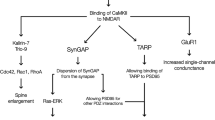Abstract
Using immunohistochemistry, we stained cells with BrdU (for detection of newly formed cells), NeuN (a neuronal specific marker), c-Fos (a marker of neuronal plasticity), and ApoDNA (marker of apoptotic cells) in the cerebellar vermis, dentate gyrus and CA1-CA4 fields of the hippocampus, motor, and retrosplenial cortex of the right and left brain hemispheres in adult rats. Animals were trained in spatial skills in the Morris water maze or were subjected to a soft forced-swimming test 6 months after a 14-day intracerebral administration of BrdU. Significant differences in the amount and composition of the labeled cells in the trained and control rats were found. The relationship between the number of new neural cells and the parameters of the formation of long-term spatial memory was determined. The results indicate that the newly formed neurons with an age of 6 months, as well as the neural cell precursors of the relevant brain structures, are selectively involved in the support of long-term spatial memory.
Similar content being viewed by others
References
Gomazkov, O.A., Neirogenez kak adaptivnaya funktsiya mozga (Neurogenesis as an Adaptive Function of the Adult Brain), Moscow: IKAR, 2013.
Koehl, M. and Abrous, D.N., Eur. J. Neurosci., 2011, vol. 33, pp. 1101–1114.
Shyder, J.S. and Cameron, H.A., Behav. Brain Res., 2012, vol. 227, pp. 384–390.
Zhao, C., Deng, W., and Gage, F.H., Cell, 2008, vol. 132, pp. 645–660.
Gould, E. and Gross, C.G., J.Neurosci., 2002, vol. 22, pp. 619–623.
Kim, W.R., Christian, K., Ming, G.L., and Song, H., Behav. Brain Res., 2012, vol. 227, pp. 470–479.
Chae, C.H., Lee, H.C., Jung, S.L., Kim, T.W., Kim, N.S., and Kim, H.T., Neuroscience, 2012, vol. 212, pp. 30–37.
Ramirez-Amaya, V., Marrone, D.F., Gage, F.H., Warley, P.H., and Barnes, C.A., J. Neurosci., 2006, vol. 26, pp. 1237–1241.
Zhao, M., Momma, S., Delfani, K., Carlen, M., Cassidy, R.M., Johanson, C.D., Brismar, H., Shupliakov, O., Frisen, J., and Janson, A.M., Proc. Natl. Acad. Sci. USA, 2003, vol. 100, pp. 1925–1930.
Paxinos, G. and Watson, C., The Rat Brain in Steriootaxic Coordinates, Oxford: Acad. Press, 1998.
Kempermann, G., Adult Neurogenesis, Stem Cells and Neuronal Development in Brain, Oxford: University Press, 2005.
Sherstnev, V.V., Yurasov, V.V., Storozheva, Z.I., Gruden’, M.A., and Proshin, A.T., Neirokhimiya, 2010, vol. 27, pp. 130–127.
Herdegen, T. and Leah, J.D., Brain Res. Rev., 1998, no. 28, pp. 370–490.
Stone, S.S.D., Teixeira, C.M., Zaslavsky, R., Wheeler, A.L., Martinez-Canabal, A., Wang, A.H., Sakaguchi, M., Lozano, A.M., and Frankland, P.W., Hippocampus, 2011, vol. 21, pp. 1348–1362.
Coras, R., Siebzehnrubl, F.A., Pouli, E., et al., Brain, 2010, vol. 133, pp. 3359–3372.
Leuner, D., Gould, E., and Shors, T.J., Hippocampus, 2006, vol. 16, pp. 216–224.
Lemaire, V., Tronel, S., Montaron, M., Fabre, F., Dugast, E., and Abrous, D.N., J. Neurosci., 2012, vol. 32, pp. 3101–3108.
Marrone, D.F., Ramires-Amaya, V., and Barnes, C., Hippocampus, vol. 22, pp. 1134–1142.
Cameron, H.A. and Dayer, A.G., Biol. Psychiatry, 2008, vol. 63, pp. 650–655.
Sandoval, C.J., Martinez-Claros, M., Bello-Medina, O., Perez, O., and Ramirez-Amaya, V., Plos One, 2011, vol. 6, pp. e17689.
Sherstnev, V.V., Abstracts of Papers, Neirokhimicheskie mekhanizmy formirovaniya adaptivnykh i plasticheskikh sostoyanii mozga (Neurochemical mechanisms of the formation of the adaptive and plastic states of the brain), St. Petersburg, 2008, p. 161.
Aleksandrov, Yu.I., Zh. Vyssh. Nerv. Deiat. I.P. Pavlova, 2005, vol. 55, pp. 842–860.
Author information
Authors and Affiliations
Corresponding author
Additional information
Original Russian Text © V.V. Sherstnev, M.A. Gruden’, O.N. Golubeva, Yu.I. Aleksandrov, O.A. Solov’eva, 2015, published in Neirokhimiya, 2015, Vol. 32, No. 1, pp. 19–26.
Rights and permissions
About this article
Cite this article
Sherstnev, V.V., Gruden’, M.A., Golubeva, O.N. et al. Long-lived newly formed neurons in the mature brain are involved in the support of learning and memory processes. Neurochem. J. 9, 13–19 (2015). https://doi.org/10.1134/S1819712415010080
Received:
Published:
Issue Date:
DOI: https://doi.org/10.1134/S1819712415010080




